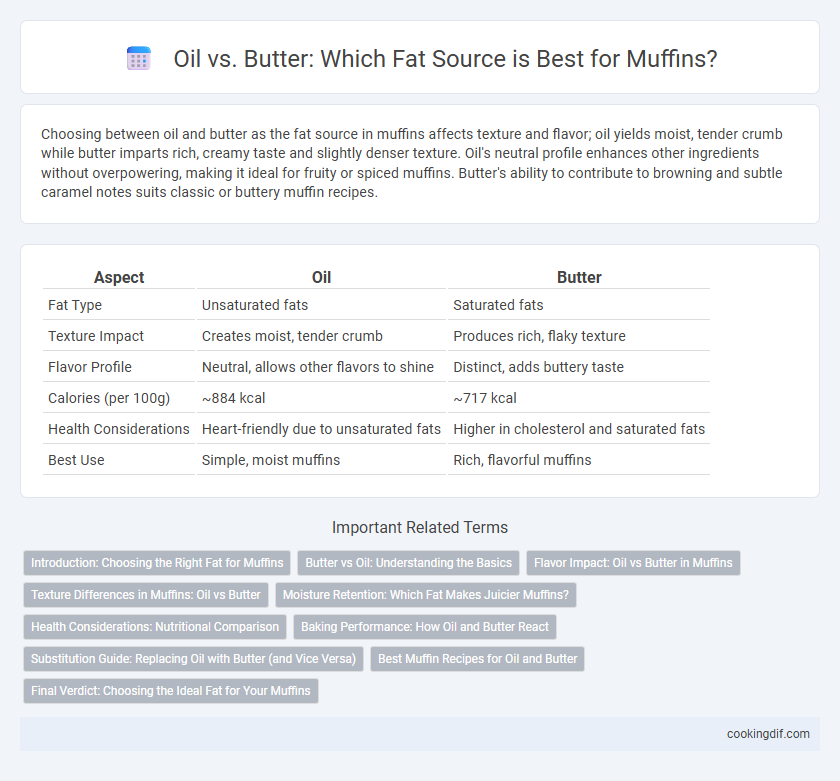Choosing between oil and butter as the fat source in muffins affects texture and flavor; oil yields moist, tender crumb while butter imparts rich, creamy taste and slightly denser texture. Oil's neutral profile enhances other ingredients without overpowering, making it ideal for fruity or spiced muffins. Butter's ability to contribute to browning and subtle caramel notes suits classic or buttery muffin recipes.
Table of Comparison
| Aspect | Oil | Butter |
|---|---|---|
| Fat Type | Unsaturated fats | Saturated fats |
| Texture Impact | Creates moist, tender crumb | Produces rich, flaky texture |
| Flavor Profile | Neutral, allows other flavors to shine | Distinct, adds buttery taste |
| Calories (per 100g) | ~884 kcal | ~717 kcal |
| Health Considerations | Heart-friendly due to unsaturated fats | Higher in cholesterol and saturated fats |
| Best Use | Simple, moist muffins | Rich, flavorful muffins |
Introduction: Choosing the Right Fat for Muffins
Oil creates moist, tender muffins by retaining more moisture during baking, making it ideal for dense, rich textures. Butter contributes a rich, creamy flavor and a slightly firmer crumb, preferred for traditional, fluffy muffins with a golden crust. Understanding the impact of fat type on muffin texture and taste helps in selecting the best fat source for desired baking outcomes.
Butter vs Oil: Understanding the Basics
Butter provides a rich, creamy flavor and firmer texture to muffins due to its milk solids and water content, which create a tender crumb and enhanced browning. Oil, being 100% fat, results in moister, softer muffins with a lighter crumb, making it ideal for recipes requiring extended freshness. Choosing between butter and oil depends on desired taste and texture, with butter favoring richness and oil promoting moisture retention.
Flavor Impact: Oil vs Butter in Muffins
Butter imparts a rich, creamy flavor and tender crumb to muffins, enhancing overall taste with its natural dairy notes. Oil, being neutral in flavor, results in moist, lighter textured muffins but lacks the distinctive buttery aroma and depth. Choosing butter over oil elevates the muffin's flavor complexity, making it a preferred fat source for more flavorful baked goods.
Texture Differences in Muffins: Oil vs Butter
Oil creates a moist and tender crumb in muffins due to its liquid state at room temperature, allowing for a softer texture. Butter, solid at room temperature, contributes to a denser, richer crumb with a slightly crisp crust thanks to the creaming process. Choosing between oil and butter significantly impacts the final muffin texture, where oil yields lightness and moisture, while butter provides structure and flavor depth.
Moisture Retention: Which Fat Makes Juicier Muffins?
Butter typically provides richer flavor but oil excels in moisture retention for muffins, resulting in juicier textures. The liquid consistency of oil coats flour particles more effectively, reducing gluten formation and preserving softness. Choosing oil over butter can enhance muffin moistness and extend freshness without compromising taste.
Health Considerations: Nutritional Comparison
Butter contains saturated fats and cholesterol that may raise LDL cholesterol levels, whereas oil typically provides unsaturated fats that support heart health. Choosing oils like olive or canola oil increases intake of omega-3 and omega-6 fatty acids, promoting better cardiovascular function. Muffins made with oil generally have lower saturated fat content, potentially reducing the risk of heart disease compared to those made with butter.
Baking Performance: How Oil and Butter React
Oil creates a tender, moist crumb in muffins by coating flour proteins and limiting gluten formation, resulting in a softer texture. Butter contributes a rich flavor and aids in leavening by trapping air during creaming, producing a lighter, fluffier muffin structure. High melting point of butter also affects muffin shape and browning, whereas oil's liquid state ensures more consistent moisture and softness throughout baking.
Substitution Guide: Replacing Oil with Butter (and Vice Versa)
Substituting oil with butter in muffins requires using 1 1/4 times the amount of butter by weight, as butter contains about 80% fat and 20% water, affecting texture and moisture. Replacing butter with oil involves reducing the quantity slightly due to oil's 100% fat content, which results in a moister, denser muffin crumb. Understanding these ratios ensures optimal fat balance, influencing crumb tenderness, flavor richness, and baking consistency.
Best Muffin Recipes for Oil and Butter
Oil-based muffins often yield a moist and tender crumb due to the liquid fat absorbing evenly in the batter, making them ideal for recipes like fruit or vegetable muffins. Butter contributes a rich, buttery flavor and creates a firmer texture with a slightly crisp crust, perfect for classic blueberry or chocolate chip muffin recipes. Choosing between oil and butter depends on desired texture and flavor, with oil enhancing moisture and butter adding depth and structure.
Final Verdict: Choosing the Ideal Fat for Your Muffins
Butter imparts a rich flavor and tender crumb to muffins, making it ideal for a classic, buttery taste, whereas oil yields moist, denser muffins with a lighter texture suitable for fruit-based varieties. Health-conscious bakers may prefer oil for its heart-friendly unsaturated fats, while butter offers a more distinct, indulgent flavor profile. Ultimately, the choice between oil and butter hinges on desired texture, flavor intensity, and nutritional preferences tailored to the muffin recipe.
Oil vs Butter for muffin fat source Infographic

 cookingdif.com
cookingdif.com